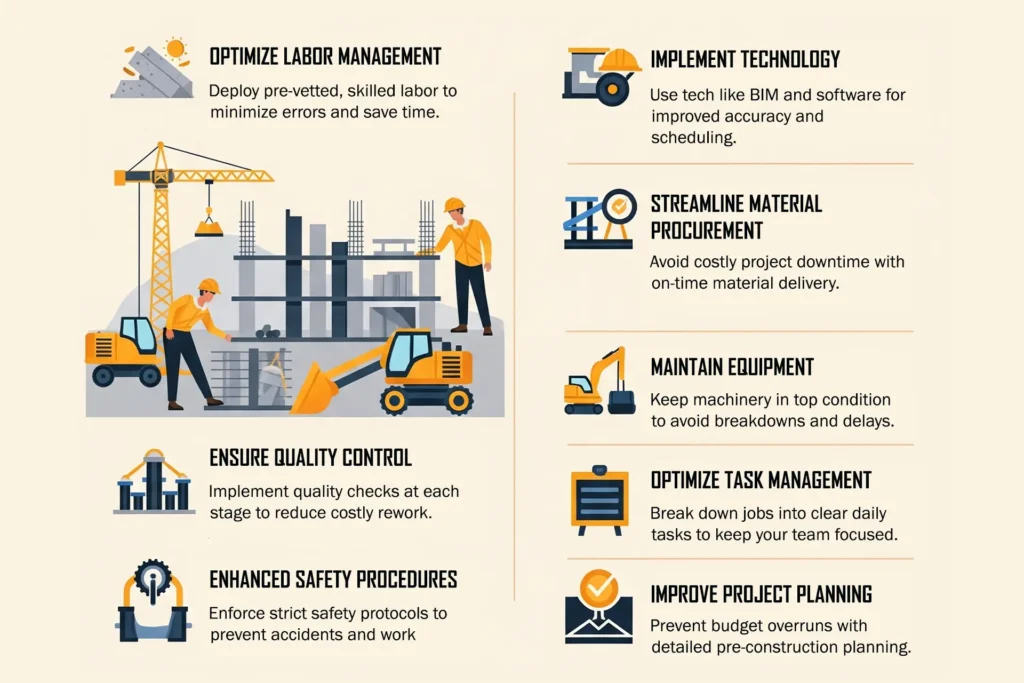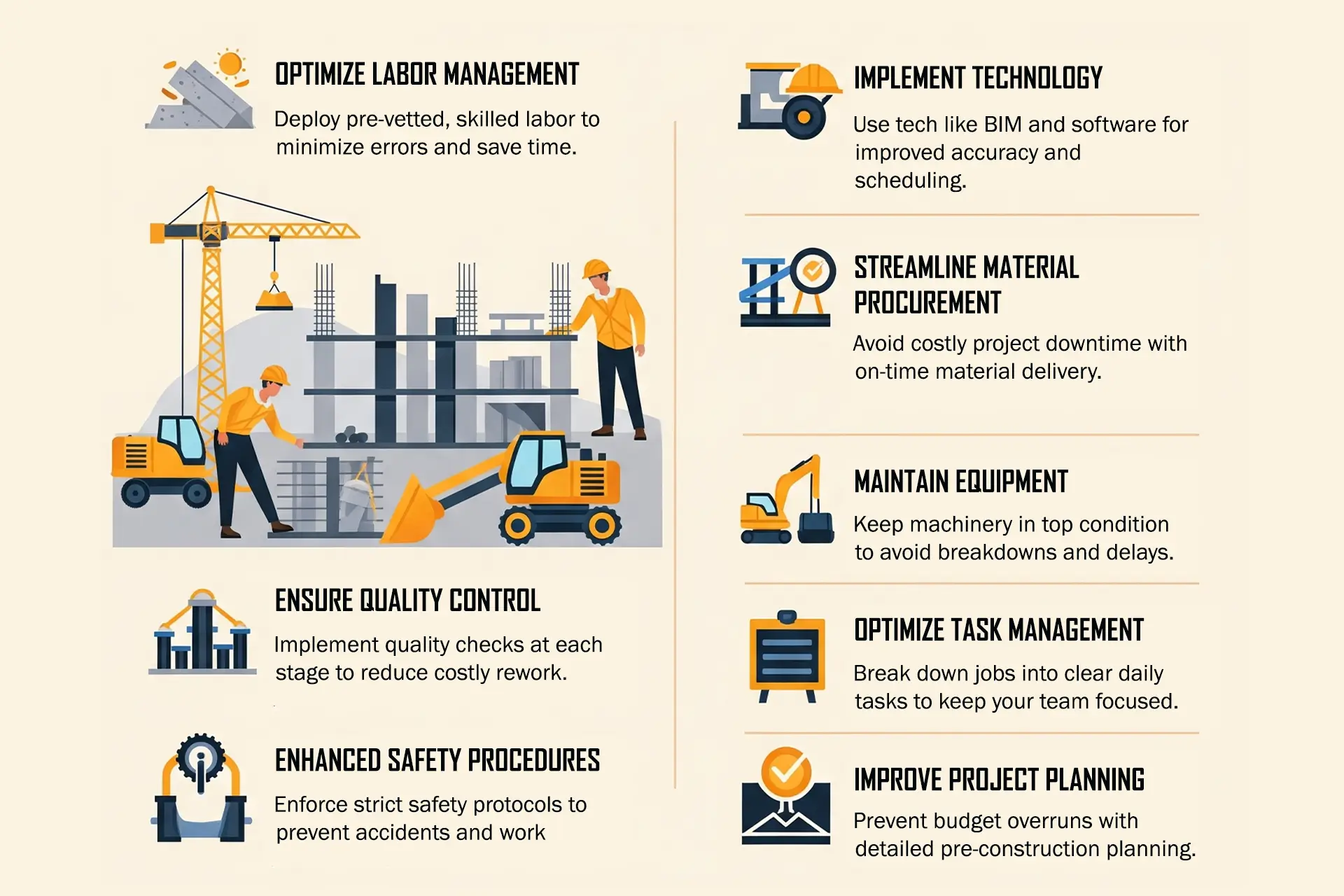
Key Takeaways
Philadelphia contractors can significantly boost productivity by implementing strategic planning, technology adoption, and workforce development to overcome the construction industry’s historically low 1% annual productivity growth.
- Implement 3-week look-ahead scheduling to reduce delays by 23% and align labor and materials with project phases proactively
- Leverage digital tools like BIM, AR, and real-time data analytics to achieve 10-15% cost savings and reduce site documentation time by 15x
- Invest in worker upskilling programs – a 10% increase in workforce training translates to a 7% productivity boost
- Apply lean construction principles to eliminate eight types of waste and create reliable workflows based on downstream demand
- Combine technology adoption with workforce reskilling to potentially boost productivity by 50-60% according to McKinsey research
The key to success is addressing planning inefficiencies, embracing construction technology, and developing workforce capabilities. This integrated approach transforms the $177 billion annual rework problem into a competitive advantage through better coordination, reduced errors, and enhanced project delivery speed.
Introduction
Did you know that productivity in construction industry has averaged a mere 1% growth over the past 20 years? That’s significantly below the world economy standard of 2.8% – a gap that represents a potential $1.6 trillion in unrealized construction spending.
For Philadelphia contractors, this productivity challenge is especially concerning. In fact, 73% of Philadelphia contractors experienced significant material delays in 2024, affecting project timelines and budgets, while construction delays in the city result in an average 23% increase in project costs. Furthermore, 68% of Philadelphia construction projects face legal challenges within their first year.
However, there’s good news. Research shows that a 10% increase in workforce training translates to a 7% productivity boost, and implementing technologies like AI and advanced data analytics could yield cost savings of 10% to 15% on construction projects.
Understanding Low Productivity in the Construction Industry
The productivity in construction industry has seen a concerning decline over the decades. Construction workers in 2020 actually produced less than workers did in 1970, a trend that affects contractors across the nation, including those in Philadelphia. This lagging productivity isn’t just a minor inconvenience—it represents trillions in unrealized economic potential.
Why productivity matters for Philadelphia projects
Philadelphia’s construction sector faces unique challenges that make productivity improvement particularly crucial. Construction productivity directly impacts profit margins, project timelines, and ultimately, the city’s development. Consequently, when productivity lags, construction costs rise 1-3% annually on top of general inflation. Between 2015 and 2023, construction prices rose by 52% in the United States, putting additional pressure on Philadelphia contractors already dealing with tight budgets and deadlines.
Common causes of low productivity on job sites
Several factors contribute to low productivity in the construction industry:
- Labor shortages and skill gaps: 45% of contractors saw labor productivity decline in 2023, primarily due to a lack of qualified workers.
- Poor planning and coordination: Misalignment between labor, materials, and project phases leads to inefficiencies.
- Fragmented value chains: The project lifecycle involves numerous players with different priorities, creating coordination challenges.
- Excessive subcontracting: Many subcontractors lack effective governance and talent management.
- On-site disruptions: Overcrowded work areas, reworks, out-of-sequence work, and project changes all impact productivity.
How to measure productivity in construction industry
Measuring productivity accurately presents challenges due to the varied nature of construction projects. Nevertheless, most experts measure construction productivity as output per labor hour. This can be expressed in physical quantities (square feet completed) or financial terms (value added per worker).
The U.S. Bureau of Labor Statistics tracks productivity for four construction sectors: single-family residential, multi-family residential, industrial building, and highway construction. Additionally, a more precise measurement involves calculating the labor productivity index, which compares productivity under different work conditions to a baseline.
Monitoring productivity enables you to detect losses early and take corrective action before they significantly impact project timelines. For optimal results, track productivity by trade or discipline to identify specific issues and analyze labor hours against units installed regularly.
How to Improve Productivity on a Construction Site with Better Planning
Effective planning is the cornerstone of boosting productivity in the construction industry. According to research, robust planning processes are fundamental for increasing productivity and establishing successful teams. By implementing strategic planning techniques, Philadelphia contractors can drastically reduce delays and maximize efficiency on job sites.
Using look-ahead scheduling to reduce delays
A 3-week look-ahead schedule provides a detailed plan of upcoming tasks and activities, essentially offering a zoomed-in view of your overall project schedule. This approach allows project managers to focus on the immediate future and plan work activities with appropriate detail. Look-ahead scheduling enables you to:
- Identify potential issues before they occur
- Coordinate subcontractors more effectively
- Track materials and resource requirements proactively
- Maintain flexibility while preserving the integrity of the project schedule
Regular updates to your look-ahead schedule, typically conducted weekly with key stakeholders, foster improved communication and collaboration throughout the project.
Aligning labor and materials with project phases
Timely labor resource planning requires understanding the necessary knowledge and skills at specific project stages, ensuring adequate personnel availability when required. For materials, implement efficient procurement procedures by:
First, establish strong supplier relationships to reduce shortages. Second, adopt materials management systems to track consumption effectively. Third, consider just-in-time delivery practices to minimize storage requirements.
This coordination ensures construction runs smoothly while minimizing delays and costs.
Avoiding rework through clear task sequencing
Rework costs the US construction industry an estimated $177 billion annually in labor costs alone. Moreover, proper sequencing is crucial as out-of-sequence work is a leading cause of rework.
To prevent rework through better sequencing:
Establish clear precedence relationships between activities to maintain structural integrity and technical requirements. Develop comprehensive documentation—including blueprints, safety plans, timelines, and budgets—to align all teams’ understanding of expectations. Additionally, standardize processes to minimize individual discrepancies, guaranteeing consistent results across diverse team contributions.
Through methodical planning and clear task sequencing, your construction projects will experience fewer disruptions, greater efficiency, and improved productivity.
Leveraging Technology to Improve Construction Productivity
Technology adoption offers a promising path to overcome low productivity in the construction industry. With the right digital tools, Philadelphia contractors can significantly boost efficiency and reduce project costs.
Digital tools for real-time site coordination
Modern construction management platforms enable seamless communication between field teams and office staff. Software solutions like Trimble Project Sight provide real-time integration and workflow automation, allowing project managers to track progress, optimize resource allocation, and identify potential challenges proactively. Similarly, OpenSpace uses Spatial AI technology to document jobsites 15 times faster and reduce site travel by 50%. These platforms streamline QA/QC processes, simplify RFI handling, and facilitate punch list management.
BIM and AR for better planning and visualization
Building Information Modeling (BIM) combined with Augmented Reality (AR) creates powerful visualization capabilities for construction teams. BIM leverages data to create digital models that provide clearer project overviews, minimizing errors and rework. When integrated with AR, teams can overlay these models onto physical construction sites, enabling real-time progress tracking synchronized with project timelines. This combination enhances design understanding, fosters better communication, and supports informed decision-making.
Using data to track and improve site efficiency
Real-time data analytics is reshaping construction site management practices. Construction firms can improve project management and optimize costs by collecting and analyzing information from various sources. Notably, over 45% of construction companies adopt digital analytics tools to capitalize on market opportunities. This approach enables better decision-making, increases productivity, optimizes resource allocation, and facilitates predictive equipment maintenance.
Wearables and safety tech to reduce downtime
Construction wearables are making significant impacts on both safety and productivity:
- Smart helmets with thermal imaging, hazard sensors, and communication capabilities alert workers to dangers.
- Exoskeletons support workers during lifting tasks, decreasing injuries and boosting productivity.
- Biometric monitoring devices track vital signs to prevent health-related incidents
These technologies collectively help reduce the more than 1,000 construction worker deaths that occur annually while simultaneously improving efficiency on Philadelphia projects.
Training and Lean Practices to Boost Labor Productivity in Construction Industry
Beyond technology and planning, investing in human capital through training remains one of the most effective ways to enhance labor productivity in construction industry. The World Economic Forum estimates over 1 billion workers will need reskilling by 2030 due to technological changes, making upskilling a critical priority for Philadelphia projects and construction companies.
Upskilling workers for modern tools and methods
Strategic training programs equip your workforce with the skills needed to operate modern construction technologies effectively. Despite widespread technology adoption, 81% of HR leaders identify the workforce skills gap as a self-inflicted problem resulting from underinvestment in learning resources. To address this challenge, implement:
- Online training platforms that provide flexible learning opportunities for construction workers to access courses on project management, safety standards, and software applications at their own pace
- Advanced certifications in specialized areas like welding, HVAC installation, electrical systems, or sustainable construction
- Peer training programs that leverage experienced workers’ knowledge to upskill newer team members while building team cohesion
Notably, workers with digital skills earn 20% more and typically stay longer with companies that invest in their development.
Lean construction principles for waste reduction
Lean construction emphasizes maximizing value while minimizing waste through better communication, collaboration, planning, and scheduling. The Lean Construction Institute identifies eight types of waste to eliminate: defects, overproduction, waiting, not utilizing talent, transportation, inventory, motion, and extra processing.
Implementing lean principles involves mapping your value stream—identifying all processes necessary to deliver customer value and eliminating non-value-adding steps. Additionally, creating reliable workflows depends on work being released based on downstream demand, often managed by those performing the work.
Creating a culture of continuous improvement
Fostering a culture of continuous learning is essential for keeping pace with rapid advancements in construction technology. This approach involves regular reflection on processes through methods like Plus/Delta discussions and implementing Plan-Do-Check-Adjust (PDCA) cycles.
For successful implementation, ensure leadership commitment and employee engagement at all levels. McKinsey research indicates that investing in workforce reskilling alongside other improvements could boost productivity by 50-60%, demonstrating the significant impact of these practices on construction site efficiency.
Conclusion
Unlock significant productivity improvements in the construction industry for Philadelphia contractors tackling 2025’s unique challenges. While the construction sector has often trailed others in efficiency, our proven strategies at Philly Trade Experts can bridge this gap. Enhance project outcomes with look-ahead scheduling and optimized resource alignment to prevent costly delays. Embrace cutting-edge digital tools for real-time coordination and data-driven insights, transforming your construction site’s performance.
Contact us at (215) 555-1234, email [email protected], or visit phillytradeexperts.com to elevate your productivity today.
FAQs
To increase productivity, focus on implementing look-ahead scheduling, leveraging digital tools for real-time coordination, adopting BIM and AR for better planning, using data analytics to track site efficiency, and investing in worker training programs. These strategies can help reduce delays, minimize rework, and improve overall project efficiency.
Technology can significantly enhance productivity through digital tools for real-time site coordination, BIM and AR for better planning and visualization, data analytics for tracking and improving efficiency, and wearables for improved safety. These technologies can lead to cost savings of 10-15% on construction projects and reduce site documentation time by up to 15 times.
Worker training is crucial for boosting productivity. Upskilling programs that focus on modern tools and methods can lead to a 7% productivity boost for every 10% increase in workforce training. Additionally, workers with digital skills tend to earn 20% more and stay longer with companies that invest in their development.
Lean construction principles focus on maximizing value while minimizing waste through better communication, collaboration, planning, and scheduling. By identifying and eliminating eight types of waste (defects, overproduction, waiting, not utilizing talent, transportation, inventory, motion, and extra processing), contractors can create more reliable workflows and significantly improve productivity.
Labor shortages and skill gaps, poor planning and coordination, fragmented value chains, excessive subcontracting, and on-site disruptions such as overcrowded work areas and out-of-sequence work often cause low productivity in construction. Addressing these issues through better planning, technology adoption, and workforce development can help boost productivity significantly.


